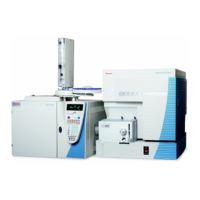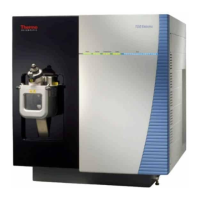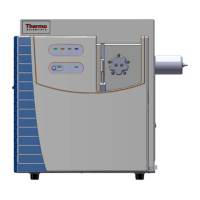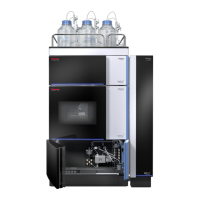1
Introduction
Scan Modes
4 TSQ Series Hardware Manual Thermo Scientific
The TSQ system mass analyzer has three rod assemblies.
2
The first and third rod assemblies,
Q1 and Q3, are quadrupoles, and the second rod assembly, Q2, is a square-profile
quadrupole.
Rod assemblies can operate in either of two capacities:
• As ion transmission devices
• As mass analyzers
If only RF voltage is applied, a rod assembly serves as an ion transmission device that passes all
ions within a large range of mass-to-charge ratios (that is, virtually all ions present).
When you apply both RF and dc voltages to a rod assembly, the separation of ions of different
mass-to-charge ratios occurs. This separation allows the rod assembly to serve as a mass
analyzer.
On the TSQ mass spectrometer, the quadrupole rod assemblies can operate with RF and
dc voltages or with only RF voltage. That is, Q1 and Q3 can act either as mass analyzers or
ion transmission devices. The Q2 rod assembly operates exclusively with RF voltage. Thus,
Q2 is always an ion transmission device. For a summary of how the rod assemblies function in
several of the major scan modes, see Table 1.
.
a
Scan = full scan or transmission of selected ions
b
Pass all ions or fragments = pass ions or fragments within a wide range of mass-to-charge ratios
c
Set = set to pass ions of a single mass-to-charge ratio or a set of mass-to-charge ratios
d
Fragment ions = collisions with argon gas cause ions to fragment
2
A rod assembly is a regular array of metal rods. See “Mass Analyzer” on page 28 for a discussion of the rod
assemblies used on the TSQ Series instrument.
Table 1. Summary of scan modes
Scan mode Q1 quadrupole Q2 collision cell Q3 quadrupole
Q1MS Scan
a
Pass all ions
b
Pass all ions
Q3MS Pass all ions Pass all ions Scan
Product Set
c
Fragment ions
d
, then pass all
fragments
Scan
Parent Scan Fragment ions, then pass all
fragments
Set
Neutral Loss Scan Fragment ions, then pass all
fragments
Scan

